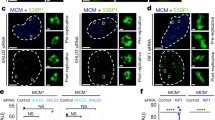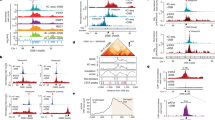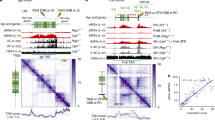Abstract
The repair of DNA double-strand breaks (DSBs) is critical for the maintenance of genome integrity. The first step in DSB repair by homologous recombination is the processing of the ends by one of two resection pathways, executed by the Saccharomyces cerevisiae Exo1 and Sgs1–Dna2 machineries. Here we report in vitro and in vivo studies that characterize the impact of chromatin on each resection pathway. We find that efficient resection by the Sgs1–Dna2–dependent machinery requires a nucleosome-free gap adjacent to the DSB. Resection by Exo1 is blocked by nucleosomes, and processing activity can be partially restored by removal of the H2A–H2B dimers. Our study also supports a role for the dynamic incorporation of the H2A.Z histone variant in Exo1 processing, and it further suggests that the two resection pathways require distinct chromatin remodeling events to navigate chromatin structure.
This is a preview of subscription content, access via your institution
Access options
Subscribe to this journal
Receive 12 print issues and online access
$189.00 per year
only $15.75 per issue
Buy this article
- Purchase on Springer Link
- Instant access to full article PDF
Prices may be subject to local taxes which are calculated during checkout







Similar content being viewed by others
References
Khanna, K.K. & Jackson, S.P. DNA double-strand breaks: signaling, repair and the cancer connection. Nat. Genet. 27, 247–254 (2001).
Zou, L. & Elledge, S.J. Sensing DNA damage through ATRIP recognition of RPA-ssDNA complexes. Science 300, 1542–1548 (2003).
Krogh, B.O. & Symington, L.S. Recombination proteins in yeast. Annu. Rev. Genet. 38, 233–271 (2004).
Zhu, Z., Chung, W.H., Shim, E.Y., Lee, S.E. & Ira, G. Sgs1 helicase and two nucleases Dna2 and Exo1 resect DNA double-strand break ends. Cell 134, 981–994 (2008).
Mimitou, E.P. & Symington, L.S. Sae2, Exo1 and Sgs1 collaborate in DNA double-strand break processing. Nature 455, 770–774 (2008).
Gravel, S., Chapman, J.R., Magill, C. & Jackson, S.P. DNA helicases Sgs1 and BLM promote DNA double-strand break resection. Genes Dev. 22, 2767–2772 (2008).
Budd, M.E., Choe, W.C. & Campbell, J.L. DNA2 encodes a DNA helicase essential for replication of eukaryotic chromosomes. J. Biol. Chem. 270, 26766–26769 (1995).
Szankasi, P. & Smith, G.R. A role for exonuclease I from S. pombe in mutation avoidance and mismatch correction. Science 267, 1166–1169 (1995).
Tsubouchi, H. & Ogawa, H. Exo1 roles for repair of DNA double-strand breaks and meiotic crossing over in Saccharomyces cerecisiae. Mol. Biol. Cell 11, 2221–2233 (2000).
Cotta-Ramusino, C. et al. Exo1 processes stalled replication forks and counteracts fork reversal in checkpoint-defective cells. Mol. Cell 17, 153–159 (2005).
Hackett, J.A. & Greider, C.W. End resection initiates genomic instability in the absence of telomerase. Mol. Cell Biol. 23, 8450–8461 (2003).
Bertuch, A.A. & Lundblad, V. EXO1 contributes to telomere maintenance in both telomerase-proficient and telomerase-deficient Saccharomyces cerevisiae. Genetics 166, 1651–1659 (2004).
Niu, H. et al. Mechanism of the ATP-dependent DNA end-resection machinery from Saccharomyces cerevisiae. Nature 467, 108–111 (2010).
Szankasi, P. & Smith, G.R.A. DNA exonuclease induced during meiosis of Schizosaccharomyces pombe. J. Biol. Chem. 267, 3014–3023 (1992).
Tran, P.T., Erdeniz, N., Dudley, S. & Liskay, R.M. Characterization of nuclease-dependent functions of Exo1p in Saccharomyces cerevisiae. DNA Repair (Amst.) 1, 895–912 (2002).
Chu, W.K. & Hickson, I.D. RecQ helicases: multifunctional genome caretakers. Nat. Rev. Cancer 9, 644–654 (2009).
Chai, B., Huang, J., Cairns, B.R. & Laurent, B.C. Distinct roles for the RSC and Swi/Snf ATP-dependent chromatin remodelers in DNA double-strand break repair. Genes Dev. 19, 1656–1661 (2005).
Shim, E.Y. et al. RSC mobilizes nucleosomes to improve accessibility of repair machinery to the damaged chromatin. Mol. Cell Biol. 27, 1602–1613 (2007).
Osley, M.A., Tsukuda, T. & Nickoloff, J.A. ATP-dependent chromatin remodeling factors and DNA damage repair. Mutat. Res. 618, 65–80 (2007).
Tsukuda, T. et al. INO80-dependent chromatin remodeling regulates early and late stages of mitotic homologous recombination. DNA Repair (Amst.) 8, 360–369 (2009).
Kalocsay, M., Hiller, N.J. & Jentsch, S. Chromosome-wide Rad51 spreading and SUMO-H2A.Z-dependent chromosome fixation in response to a persistent DNA double-strand break. Mol. Cell 33, 335–343 (2009).
Chen, X. et al. The Fun30 nucleosome remodeller promotes resection of DNA double-strand break ends. Nature 489, 576–580 (2012).
Costelloe, T. et al. The yeast Fun30 and human SMARCAD1 chromatin remodellers promote DNA end resection. Nature 489, 581–584 (2012).
Papamichos-Chronakis, M., Krebs, J.E. & Peterson, C.L. Interplay between Ino80 and Swr1 chromatin remodeling enzymes regulates cell cycle checkpoint adaptation in response to DNA damage. Genes Dev. 20, 2437–2449 (2006).
Morillo-Huesca, M., Clemente-Ruiz, M., Andújar, E. & Prado, F. The SWR1 histone replacement complex causes genetic instability and genome-wide transcription misregulation in the absence of H2A.Z. PLoS ONE 5, e12143 (2010).
Halley, J.E., Kaplan, T., Wang, A.Y., Kobor, M.S. & Rine, J. Roles for H2A.Z and its acetylation in GAL1 transcription and gene induction, but not GAL1-transcriptional memory. PLoS Biol. 8, e1000401 (2010).
Zhang, H., Roberts, D.N. & Cairns, B.R. Genome-wide dynamics of Htz1, a histone H2A variant that poises repressed/basal promoters for activation through histone loss. Cell 123, 219–231 (2005).
Watanabe, S., Radman-Livaja, M., Rando, O. & Peterson, C.L. A histone acetylation switch regulates H2A.Z deposition by the SWR-C remodeling enzyme. Science 340, 195–199 (2013).
Mizuguchi, G. et al. ATP-driven exchange of histone H2AZ variant catalyzed by SWR1 chromatin remodeling complex. Science 303, 343–348 (2004).
Nishimura, K., Fukagawa, T., Takisawa, H., Kakimoto, T. & Kanemaki, M. An auxin-based degron system for the rapid depletion of proteins in nonplant cells. Nat. Methods 6, 917–922 (2009).
Shim, E.Y. et al. RSC mobilizes nucleosomes to improve accessibility of repair machinery to the damaged chromatin. Mol. Cell Biol. 27, 1602–1613 (2007).
Eggleston, A.K., O'Neill, T.E., Bradbury, E.M. & Kowalczykowski, S.C. Unwinding of nucleosomal DNA by a DNA helicase. J. Biol. Chem. 270, 2024–2031 (1995).
Finkelstein, I.J., Visnapuu, M.L. & Greene, E.C. Single-molecule imaging reveals mechanisms of protein disruption by a DNA translocase. Nature 468, 983–987 (2010).
Nimonkar, A.V. et al. BLM-DNA2-RPA-MRN and EXO1-BLM-RPA-MRN constitute two DNA end resection machineries for human DNA break repair. Genes Dev. 25, 350–362 (2011).
Wei, K. et al. Inactivation of Exonuclease 1 in mice results in DNA mismatch repair defects, increased cancer susceptibility, and male and female sterility. Genes Dev. 17, 603–614 (2003).
Giannattasio, M. et al. Exo1 competes with repair synthesis, converts NER intermediates to long ssDNA gaps, and promotes checkpoint activation. Mol. Cell 40, 50–62 (2010).
Hombauer, H., Campbell, C.S., Smith, C.E., Desai, A. & Kolodner, R.D. Visualization of eukaryotic DNA mismatch repair reveals distinct recognition and repair intermediates. Cell 147, 1040–1053 (2011).
Hombauer, H., Srivatsan, A., Putnam, C.D. & Kolodner, R.D. Mismatch repair, but not heteroduplex rejection, is temporally coupled to DNA replication. Science 334, 1713–1716 (2011).
Xu, Y. et al. Histone H2A.Z controls a critical chromatin remodeling step required for DNA double-strand break repair. Mol. Cell 48, 723–733 (2012).
Rangasamy, D. Histone variant H2A.Z can serve as a new target for breast cancer therapy. Curr. Med. Chem. 17, 3155–3161 (2010).
Sigurdsson, S., Trujillo, K., Song, B., Stratton, S. & Sung, P. Basis for avid homologous DNA strand exchange by human Rad51 and RPA. J. Biol. Chem. 276, 8798–8806 (2001).
Raynard, S., Bussen, W. & Sung, P.A. A double Holliday junction dissolvasome comprising BLM, topoisomerase IIIα, and BLAP75. J. Biol. Chem. 281, 13861–13864 (2006).
Luger, K., Rechsteiner, T.J. & Richmond, T.J. Preparation of nucleosome core particle from recombinant histones. Methods Enzymol. 304, 3–19 (1999).
Smith, C.L., Horowitz-Scherer, R., Flanagan, J.F., Woodcock, C.L. & Peterson, C.L. Structural analysis of the yeast SWI/SNF chromatin remodeling complex. Nat. Struct. Biol. 10, 141–145 (2003).
Goldstein, A.L. & McCusker, J.H. Three new dominant drug resistance cassettes for gene disruption in Saccharomyces cerevisiae. Yeast 15, 1541–1553 (1999).
Acknowledgements
This work was supported by grants from the US National Institutes of Health to N.L.A. (F32 GM096701), C.L.P. (RO1 GM54096) and P.S. (RO1 ES07061). We thank Y. Kwon (Yale University, New Haven, Connecticut, USA) for purified MRX, G. Ira (Baylor University, Houston, Texas, USA) for yeast strains, V. Borde (Institute Curie, Paris, France) for RPA antibody, C. Van (University of Massachusetts Medical School, Worcester, Massachusetts, USA) for help with the degron experiments and M. Liskay (Ohio State University, Columbus, Ohio, USA) for the Exo1 clone.
Author information
Authors and Affiliations
Contributions
N.L.A. performed all experiments, P.S. and H.N. provided purified resection enzymes, and all authors were involved in data analysis and manuscript preparation.
Corresponding author
Ethics declarations
Competing interests
The authors declare no competing financial interests.
Supplementary information
Supplementary Text and Figures
Supplementary Figures 1–7, Supplementary Tables 1 and 2 and Supplementary Note (PDF 1379 kb)
Rights and permissions
About this article
Cite this article
Adkins, N., Niu, H., Sung, P. et al. Nucleosome dynamics regulates DNA processing. Nat Struct Mol Biol 20, 836–842 (2013). https://doi.org/10.1038/nsmb.2585
Received:
Accepted:
Published:
Issue Date:
DOI: https://doi.org/10.1038/nsmb.2585
This article is cited by
-
HJURP is recruited to double-strand break sites and facilitates DNA repair by promoting chromatin reorganization
Oncogene (2024)
-
H2A.Z deposition by SWR1C involves multiple ATP-dependent steps
Nature Communications (2022)
-
Precise genome-wide mapping of single nucleosomes and linkers in vivo
Genome Biology (2018)
-
The shieldin complex mediates 53BP1-dependent DNA repair
Nature (2018)
-
CRL4Wdr70 regulates H2B monoubiquitination and facilitates Exo1-dependent resection
Nature Communications (2016)



